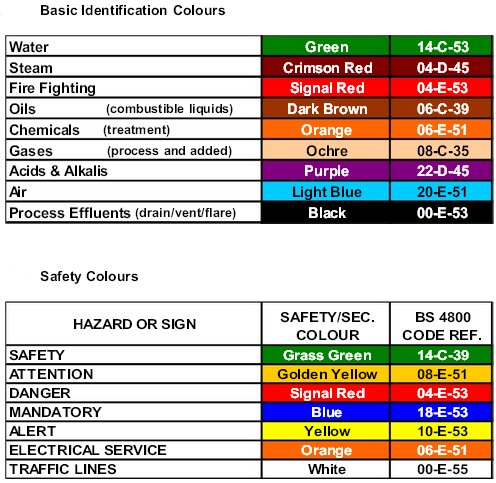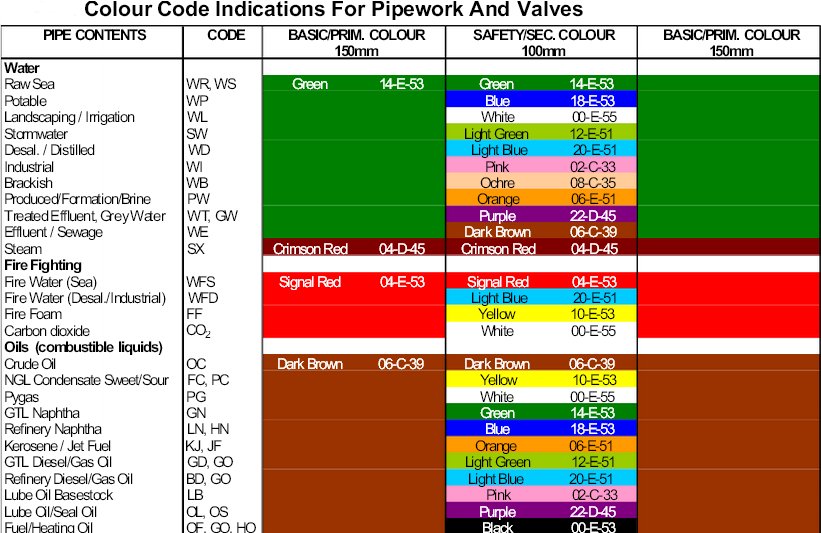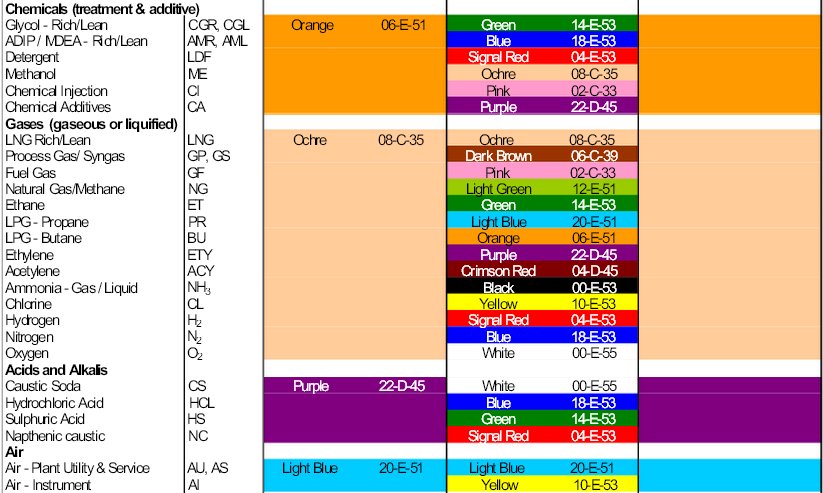 |
Satish Lele lelepiping@gmail.com |
View this page as YouTube Video Presentation
Pipes are the simplest, easiest and most economical way to move liquids and gases to where they need to be. But, it is impossible to know what a pipe contains, or the hazards liquids and gases presents, from its external appearance. In addition, the number of pipes and the complexity of piping systems in a facility is increasing. This means that a system that allows quick identification of pipe contents and potential hazards is essential. Color coding is one of the most effective ways of quickly communicating information. The color coding of pipe (markers) has long been recognized as an important part of pipe marking, and is required by all of the various pipe marking codes.
There are a variety of pipe color code systems. ANSI A13.1 is the most commonly used. Other organizations, such as IIAR, CGA and ISO, publish pipe color coding systems for specific applications. How do you know how to mark the pipes in your facility? How will new hires quickly get up to speed on pipe marking color coding? It's easy. Just use a Pipe Color Code Chart.
Pipe Color Code Charts that cover all of the major pipe marking standards in the U.S. are available free.
ANSI A13.1 Pipe Color Code Chart: ANSI A13.1 pipe marking code is the standard most often used for pipe marking. An estimated 90% of all pipes are marked using the ANSI standard. The ANSI A13.1 Pipe Color Code Chart shows the required text and background color combinations for each type of fluid. In addition code shows the required label size and locations.
Pipe marking kit: This pipe color code chart is available either laminated or non laminated. Pipe color code chart may be posted as a wall chart, providing the pipe color coding information to anyone who needs it. Other label printer options are available.
Commercial Building Color Code Chart: The color coding of pipes in commercial buildings starts with the ANSI standard and pipe marking code image expands on it by adding color bands to provide more detailed information. Graphic Products has compiled a consensus standard based on local codes and practices with the U.S. To make this information available they have published a Commercial Building Pipe Color Chart showing the color coding practices that are commonly being used in commercial buildings and schools.
IIAR (International Institute for Ammonia Refrigeration) Pipe Color Code Chart: The IIAR pipe marking system applies to ammonia pipes used in ammonia refrigeration systems. Ammonia presents unique hazards and having additional information about the pressure and liquid/vapor state of the ammonia is important. The IIAR provides a pipe marking color coding system that addresses these needs. A Pipe Color Code Chart showing the IIAR standards is available.
Graphic Products also provides Pipe Color Code Charts that show the ISO standards for marine pipe marking and the CGA standards for marking medical gas pipes.
According to ANSI/ASME A13.1, pipe markers should conform to certain requirements. The most recent update to the ANSI/ASME A13.1 code has introduced a new color scheme that specifies which colors to use for pipe labels. The code also specifies standards for the label sizes and placement.
In 2007 the ANSI/ASME A13.1 standard was updated and is now recommended for all new pipe marker applications. For facilities with existing pipe markers, it is recommended that they are updated for consistent identification.
ANSI/ASME A13.1 Standard Label Colors: The current version of the ANSI / ASME code uses a pipe labeling standards color code chart with six standard color combinations, and four user-defined combinations, as shown in the table below. The colors are based on the contents of the pipe in general, the most hazardous feature of the contents should determine the colors used.




 to get all the information as a eBook
to get all the information as a eBook
